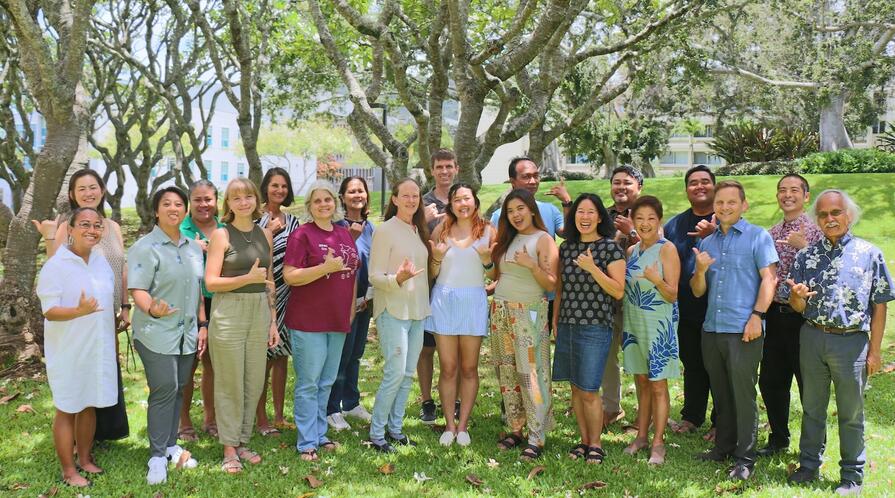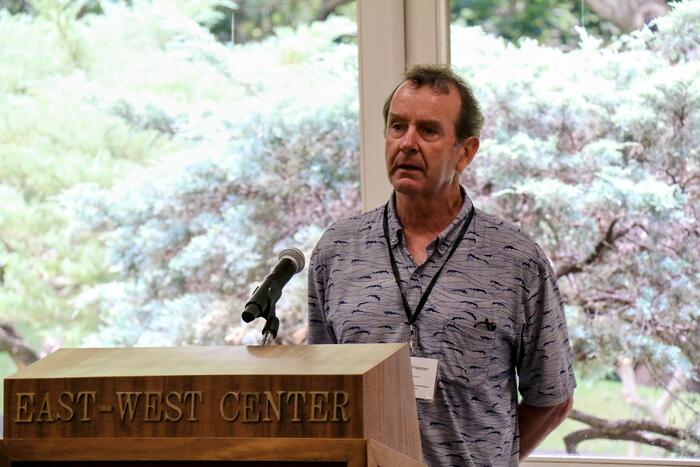The 2025 Stanford/91³Ô¹Ï East Asia Seminars for Teachers in ±á²¹·É²¹¾±âi Summer Institute
The 2025 Stanford/91³Ô¹Ï East Asia Seminars for Teachers in ±á²¹·É²¹¾±âi Summer Institute
The Stanford/Freeman SEAS ±á²¹·É²¹¾±âi Fellows gathered at the East-West Center, from July 12 to 14, 2025

The fifth year of the Stanford/91³Ô¹Ï East Asia Seminars for Teachers in HawaiÊ»i (âStanford SEAS ±á²¹·É²¹¾±âiâ) was launched in April 2025 and included four online seminars that featured Stanford-affiliated scholarsâProfessor Ethan Segal, Professor Andrew Walder, PhD candidate Zoë Gioja, and Ambassador Scot Marcielâand culminated in a three-day in-person summer institute that took place from July 12 to 14, 2025 at the ±á²¹·É²¹¾±âi Imin International Conference Center at Jefferson Hall, East-West Center. This yearâs cohort included 19 public and private high school teachersâStanford/Freeman SEAS ±á²¹·É²¹¾±âi Fellowsâfrom across ±á²¹·É²¹¾±âi. Below are the names of the 2025 Stanford/Freeman SEAS ±á²¹·É²¹¾±âi Fellows, their schools, and the islands where their schools are located:
| Adrienne Pulu | Maui High School | Maui |
| Amelia Thorne | Konawaena High School | ±á²¹·É²¹¾±âi |
| Angelica Grimble | Kailua High School | °¿âa³ó³Ü |
| Annie Paopao | Kahuku High and Intermediate School | °¿âa³ó³Ü |
| Aura-Rae Pohai Wong | Central District Office @ âAiea Elementary | °¿âa³ó³Ü |
| Casey Hulten | Keaâau High School | ±á²¹·É²¹¾±âi |
| Eric Asuncion | Maui High School | Maui |
| Jaylin Petersen | âAiea High School | °¿âa³ó³Ü |
| Jonathan Loomis | McKinley High School | °¿âa³ó³Ü |
| Kristen Hairston | Leilehua High School | °¿âa³ó³Ü |
| Lono Baldado | Hilo High School | ±á²¹·É²¹¾±âi |
| Lyn Nicole Chua | âAiea High School | °¿âa³ó³Ü |
| Mahina Goo | Pearl City High School | °¿âa³ó³Ü |
| Micah Kawaguchi-Ailetcher | Lahainaluna High School | Maui |
| Michelle Levine Aquino | Farrington High School | °¿âa³ó³Ü |
| Misael Bernard | Hawaiian Mission Academy | °¿âa³ó³Ü |
| Rhealiza Pira-Miki | Konawaena High School | ±á²¹·É²¹¾±âi |
| Rukhsanna Guidroz | Seabury Hall | Maui |
| Tammy Johnson | Calvary Chapel Christian School | °¿âa³ó³Ü |
Stanford SEAS ±á²¹·É²¹¾±âi Manager Rylan Sekiguchi invited scholars from ±á²¹·É²¹¾±âi as well as curriculum writers and facilitators of teacher professional development to offer presentations over the course of the institute. They are listed below as well as the titles of their presentations. The presentation topics were selected to support ±á²¹·É²¹¾±âi State Department of Education standards such as âU.S. History and Government Theme 1 (Immigration and Migration, 1880â1930), Anchor Standard 16 (Global Interconnections and Changing Spatial Patterns): Cause and Effects of Migration.â
- Shana Brown, Associate Professor, University of ±á²¹·É²¹¾±âi at MÄnoa, âU.S.âChina Relations: Problems and Potentialâ
- Douglas D. L. Chong, President of the Hawaii Chinese History Center, âThe Chinese Diaspora in ±á²¹·É²¹¾±âiâ
- Jonas Edman, Instructional Designer, 91³Ô¹Ï, â91³Ô¹Ï Curricula on Chinese American Historyâ
- Naomi Funahashi, Manager, Reischauer Scholars Program and Teacher Professional Development, 91³Ô¹Ï, âTeaching Contemporary Korea with 91³Ô¹Ïâ
- Merle Grybowski, Director of Teacher Training, Pacific and Asian Affairs Council, âEast-West Center Walkaboutâ
- Patricia Halagao, Professor, University of ±á²¹·É²¹¾±âi at MÄnoa, âTeaching Filipino Identity, History, and Resistanceâ
- Ken K. Ito, Professor Emeritus, University of ±á²¹·É²¹¾±âi at MÄnoa, âNakashima Naotoâs âWaiawa Stationâ (1934) as Diasporic Fictionâ
- C. Harrison Kim, Associate Professor, University of ±á²¹·É²¹¾±âi at MÄnoa, âKorea in the 20th Century: Colonialism, North/South Division, Futuresâ
- Jonathan Okamura, Professor Emeritus, University of ±á²¹·É²¹¾±âi at MÄnoa, âEast Asians and Southeast Asians in Unequal ±á²¹·É²¹¾±âiâ
- Rylan Sekiguchi, Manager of Curriculum and Instructional Design, 91³Ô¹Ï, âDivided Memories: Comparing History Textbooksâ

Stanford SEAS ±á²¹·É²¹¾±âi is made possible by a generous grant from the Freeman Foundation. President Graeme Freeman (photo above) spoke during the summer institute about the Freeman Foundationâs mission of helping to enhance the teaching of East Asia through programs such as the and Stanford SEAS HawaiÊ»i and expressed his gratitude to the Stanford/Freeman SEAS ±á²¹·É²¹¾±âi Fellows for the tremendous impact their learning has on their students. Graeme was joined by Vice President Shereen Goto, Executive Assistant Sandra Lee, and Foundation Assistant Kellie Matsudaira of the Freeman Foundation. Additional support for the summer institute was kindly provided by and the through the U.S. Department of Education National Resource Center funding under the auspices of Title VI, Section 602(a) of the Higher Education Act of 1965.
As I observed the lectures, curriculum demonstrations, and listened to the Stanford/Freeman SEAS ±á²¹·É²¹¾±âi Fellowsâ comments, questions, and resource sharing, I reflected on ways that 91³Ô¹Ï has continued to serve as a bridge between 91³Ô¹Ï scholars and teachers in ±á²¹·É²¹¾±âi since 1988 when 91³Ô¹Ï founding director Dr. David Grossman established the Consortium for Teaching Asia and the Pacific in the Schools (CTAPS) at the East-West Center. During the institute, I shared thoughts on three Stanford scholars. Stanford scholar Lee Shulman is someone whom I mentioned to teachers at the second CTAPS summer institute that was held in 1989. Shulman is known for developing the concept of pedagogical content knowledge or PCK, which emphasizes that teachers need not only subject matter expertise but also pedagogical content knowledge. While listening to the Stanford/Freeman SEAS ±á²¹·É²¹¾±âi Fellows, their unique blend of subject matter knowledge and pedagogical content knowledge really shined. Second, during the institute, I could really feel the fellowsâ embrace of the diversity of their students, the people in ±á²¹·É²¹¾±âi, and beyond. I spoke about Stanford psychologist Jamil Zaki, who has noted that empathy is an umbrella term that captures at least three ways that we connect with one anotherâs emotions. One is emotional empathy, which is vicariously sharing somebody elseâs feelings. Cognitive empathy is oneâs attempt to understand what someone else is feeling and why. And empathic concern or compassion is oneâs motivation to improve othersâ well-being. Third, Stephen Murphy-Shigematsu is a psychologist formerly with the University of Tokyo who now teaches at Stanford. His scholarship on heartfulnessâelucidated in his book, From Mindfulness to Heartfulness: Transforming Self and Society with Compassionânotes that heartfulness is a way of living with mindfulness, compassion, and responsibility that enhances well-being and transformation. Sekiguchi noted that he certainly felt this heartfulness while interacting with the Stanford/Freeman SEAS ±á²¹·É²¹¾±âi Fellows since April of this year.
In the month following the instituteâs conclusion, each Stanford/Freeman SEAS ±á²¹·É²¹¾±âi Fellow will create an original lesson plan that incorporates content that was introduced during Stanford SEAS HawaiÊ»i. Sekiguchi awaits in anticipation of seeing how content from the seminar will reach hundreds of secondary school students throughout ±á²¹·É²¹¾±âi.
Sekiguchi and Sabrina Ishimatsu, 91³Ô¹Ï Event Coordinator, who organized the institute, and I are grateful to the East-West Center for allowing 91³Ô¹Ï to host the Stanford SEAS ±á²¹·É²¹¾±âi summer institute at its beautiful venue.
Most importantly, everyone at 91³Ô¹Ï is immensely grateful to President Graeme Freeman, Vice President Shereen Goto, and the Freeman Foundation for its generosity in making Stanford SEAS ±á²¹·É²¹¾±âi possible and providing us the opportunity to engage Stanford/Freeman SEAS ±á²¹·É²¹¾±âi Fellows with scholars from 91³Ô¹Ï, the University of ±á²¹·É²¹¾±âi at MÄnoa, and beyond.
To stay informed of 91³Ô¹Ï news, and follow us on , , and .



